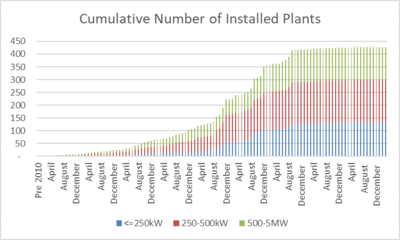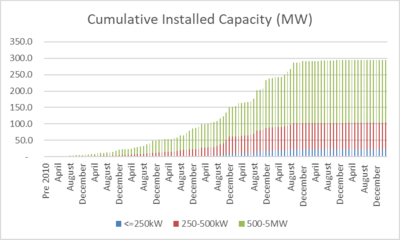Anaerobic Digestion
Anaerobic Digestion (AD) is a process where biodegradable material is broken down by micro-organisms in the absence of oxygen in an enclosed vessel. The process produces a Biogas which can be used for generating renewable power and a nutrient-rich solid/liquor known as digestate which can be used as fertiliser and compost. Anaerobic Digestion uses biodegradable waste materials from Agricultural Waste such as manure and slurry, Food Waste and Sewage Sludge. Where the process utilises Animal By-product Material, it must comply with the Animal By-Products (Enforcement) (England) Regulations 2011 requirements.
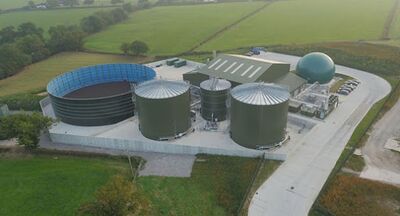
Overview
Anaerobic Digestion (AD) is a process where biodegradable material is broken down by micro-organisms in the absence of oxygen in an enclosed vessel. Biogas is produced that can be used for the generation of power (electric and heat), or refined and used as a 'biomethane', and Digestate is produced which can be used as a 'biofertiliser'.
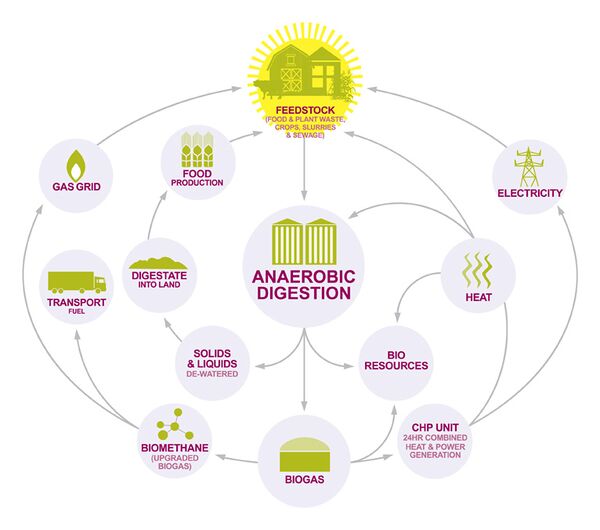
Biogas
The process produces a Biogas which is around 60% methane, 40% carbon dioxide and traces of other contaminant gas (depending on the feedstock being digested). Biogas can be combusted to provide heat, electricity, or both. Alternatively the Biogas can be 'upgraded' to pure methane, often called biomethane, by removing other gases. This pure stream of biomethane can then be injected it into the mains gas grid or used as a road fuel. One cubic metre of biogas at 60% methane content converts to 6.7 kWh energy[2].
Digestate
Digestate is a nutrient-rich substance produced by AD that can be used as a fertiliser. It consists of left over indigestible material and dead micro-organisms - the volume of digestate will be around 90-95% of what was fed into the digester. Digestate is not compost, although it has some similar characteristics. In order for the material to no longer be considered as waste and be used as a fertiliser, the digestate must meet the standards set out in the Quality protocol and PAS110[3] (SEPA position statement in Scotland[4])
Definition by Input
AD plants can be categorised in a number of different ways with different commentators using slightly different approaches and slightly different datasets. This combined with the ongoing development of plants over time (with plants moving from development into operation each year) means that it is difficult to build a definitive list of the number and types of plants in operation. As a result this page summarises data from different sources without attempting to correlate them to one another where the links are unclear.
The broad classifications by feedstock that can be used in AD are summarised in the table below including both waste and non-waste materials (with crops including maize, grass silage, energy beet and whole crop cereals) :
| BEIS | NNFCC | ADBA | Feedstock |
|---|---|---|---|
| Anaerobic Digestion | Farm AD | Agriculture | Agricultural Waste (incl. manures and slurries) |
| Crops (incl. silage and whole crops) | |||
| Food Waste (MSW and Commercial Waste sources) | |||
| Food AD | MSW/Commercial Waste | Food Waste (MSW and Commercial Waste sources) | |
| Industrial | Food Waste (at the origin of the waste, incl. Industrial Waste) | ||
| Sewage Sludge Digestion | Sewage Sludge AD | Sewage Sludge | Sewage Sludge (at water treatment site) |
This classification can be further divided by the nature of the Food Waste (i.e. ABPR and non-ABPR material) - where the process utilises ABPR materials, it must comply with the Animal By-Products (Enforcement) (England) Regulations 2011 requirements and some Agricultural plants, for example, only utilise non-ABPR material so as to avoid the need to comply with these requirements. Additionally, the three different feedstocks in the 'Agricultural' classification can be co-digested in different combinations to optimise plant productivity and yield of biogas and can be talked about in those terms.Sewage Sludge doesn't tend to be blended with other materials and tends to be a dedicated AD solution in its own right - primarily as it becomes impossible to to deliver End of Waste digestate with the introduction of Sewage Sludge as an input feedstock.
Definition by Output
The broad classifications by output are summarised in the table below (broadly by ADBA on their on-line map[5], but primarily by Ofgem via the different subsidy scheme requirements, but also BEIS via the Digest of UK Energy Statistics[6] and the DOT via the reporting on Road Transport Fuels[7]):
| Grouping | Output | Application | Subsidy | Band | Sustainability | |
|---|---|---|---|---|---|---|
| CHP | Electricity | National Grid | ROC (now CFD) | >5MW | =>25MW | |
| FIT (now SEG) | 500kW-5MW | |||||
| 'Local Wire' | 250kW-500kW | |||||
| <=250kW | <25MW >=1MW | |||||
| Heat | Building(s) | RHI | =>600kWth | |||
| <600kWth | ||||||
| Heat Network | >=200kWth | |||||
| <200kWth | ||||||
| Biomethane | Gas Grid | >80,000MWh | ||||
| <=80,000MWh | ||||||
| > 40,000MWh | <1MW | |||||
| <=40,000MWh | ||||||
| Transport | RTFO | - |
AD projects are required to report on their Biomass Sustainability according to the size of the plant (as shown in the last column of the table above) under the ROC, FIT and SEG subsidy schemes, which demonstrates sustainability of the biogas produced based upon:
- meeting greenhouse gas criteria and is made from solid biomass (i.e. Farm AD based on a crop such as maize) that also meets the land criteria
- is made from feedstock which is waste (i.e. Food AD) or
- consists of both of the above (i.e. Farm AD that is multi-streamed).
The banding levels shown for the various subsidies relate to different subsidy rates in each band and are referred to in this page and the associated subsidy pages and links.
The Chemical Process of AD
The process of AD occurs in several stages and requires a community of micro-organisms:
- Hydrolysis - large, complex polymers like carbohydrates, cellulose, proteins and fats are broken down by hydrolytic enzymes into simple sugars, amino acids and fatty acids.
- Acidogenesis - simple monomers are broken down into volatile fatty acids
- Acetogenesis - the products of acidogenesis are broken down into acetic acid, releasing hydrogen and carbon dioxide.
- Methanogenesis - bacteria called methane formers produce methane either by cleaving two acetic acid molecules to form carbon dioxide and methane, or by reduction of carbon hydroxide with hydrogen [8]
AD Technology Options
The process options are varied to manage the AD stages into the following classifications:
- Mesophilic or Thermophilic - operating at 25 to 45oC and 50 to 60oC respectively, the majority are Thermophilic in the UK
- Wet or dry
- Continuous or batch flow - the majority are continuous flow in the UK
- Single, double or multiple digesters - most are single or double in the UK and can manage the stages more efficiently
- Vertical tank or horizontal plug flow[9]
Growth in Anaerobic Digestion
Whilst the introduction of the Renewables Obligation in 2002 started to stimulate growth in larger AD projects (including 'Food AD' and 'Sewage Sludge AD') it was only really with the introduction of The FIT scheme in 2010 that the AD market really started to grow, stimulating smaller projects and especially 'Farm AD' based on crops, Agricultural Waste and in some cases Food Waste. This was also enabled by investment tax benefits for investing in these projects (EIS and SEIS especially, which reduced in impact with changes to the schemes in 2015/16 leading to less investment stimulus).
With greater focus on the collection of separate Food Waste from 2011 onwards this also stimulated the market at the time by making materials available with gate fees payable. The roll-out of Food Waste collection, however, slowed and the stimulation provided by the FIT scheme was reduced in 2017, leading to projects relying on the creation of biomethane, which in turn relied on the RHI (for injection to the gas grid) and RTFO (for use in vehicles) which has generally led to a slowing in the growth of the market.
Depending on the view taken on load factors in operational plants (i.e. the amount of power/gas production vs the plated capacity) there is presently an excess of AD capacity in relation to the feedstocks available to the plants, especially for separately collected Food Waste.
An analysis of the data provided by Office for National Statistics (ONS)[10] for the monthly FIT commissioned installations over the period of the schemes existence shows an increase from 1 plant prior to 2010 to 427 plants by March 2019, generating 294.9MW of power.
The graphs show the slowing of the cumulative growth in capacity from late 2016, linked to a change in the amounts payable under the FIT scheme
| Capacity | Cumulative Number of Plants Installed | % Split | Cumulative Capacity Installed(MW) | % Split |
|---|---|---|---|---|
| <=250kW | 133 | 31% | 23.7 | 8% |
| 250-500kW | 166 | 39% | 80.1 | 27% |
| 500-5MW | 128 | 30% | 191.1 | 65% |
| Total | 427 | 100% | 294.9 | 100% |
The table shows that by 2019, whilst the size of plants were relatively evenly distributed amongst the 3 bands of measurement/scales of plant, the larger scale projects had a dis-proportionally large installed capacity.
Number of UK Sites
At December 2018 the ONS reported the following key statistics for the number of AD sites generating electricity (extract from table 6F)[6]:
| FIT Confirmed | Other Sites | Total | |
|---|---|---|---|
| Sewage Sludge Digestion | 0 | 194 | 194 |
| Anaerobic Digestion | 419 | 199 | 618 |
| Total | 4191 | 393 | 812 |
- noted as 427 by the Ofgem reported figures above (these ONS figures appear to be reporting December 2016 figures for FIT projects, despite stating December 2018 in the table)
ADBA maintain the national database of AD plants in the UK as an online tool[5]. The online tool captures those plants which are based on four different feedstock configurations and three different power output configurations. A summary of the total plants listed is set out below, with an extract in the map to the right of MSW/Commercial Food Waste AD facilities generating electricity:
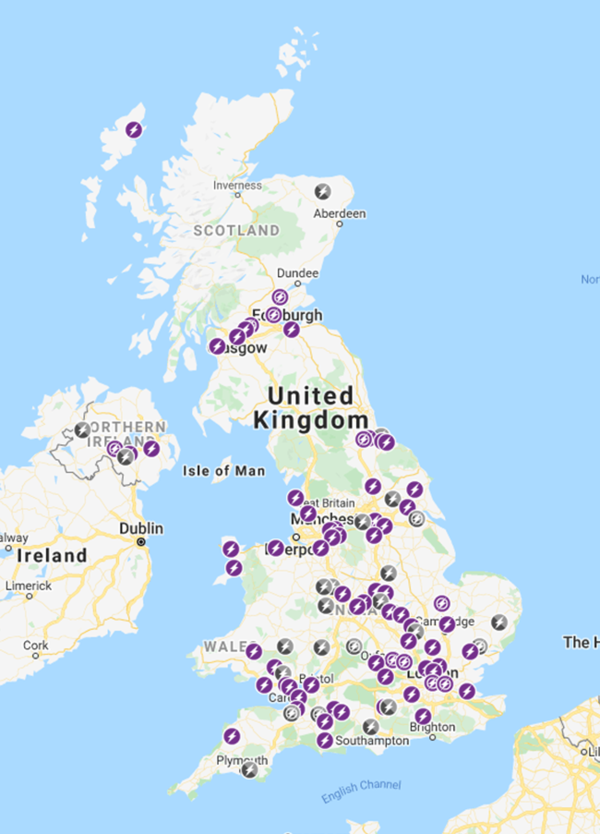
| Electricity | Heat | Biomethane | Column Total | Matching Total | |
|---|---|---|---|---|---|
| Agricultural | 314 | 30 | 67 | 411 | 374 |
| MSW/Commercial (Food Waste) | 95 | 8 | 27 | 130 | 113 |
| Industrial | 40 | 6 | 11 | 57 | 48 |
| Sewage Sludge | 163 | 0 | 9 | 172 | 163 |
| Row Total | 612 | 44 | 114 | ||
| Matching Total | 503 | 42 | 102 |
ABDA most recently suggested[11] that in 2021 there were 686 AD plants in operation in the UK and a further 269 in development.
Feedstock
The table below is reproduced from table 4.3 in the Renewable Obligation Annual Report 2017-18 by Ofgem and shows the consignments (i.e. the feedstock flows reported to AD plants, not the number of AD plants) reported as AD against the sustainability criteria required by the Biomass Sustainability reporting, although those with <1MW are not formally linked to a ROC issue[12] :
| AD Stations <1MW | AD Stations ≥1MW | AD Stations >25MW | ||
|---|---|---|---|---|
| Meets the Land Criteria | Yes | 111 | 134 | 0 |
| -"- | No | 0 | 0 | 0 |
| -"- | Exempt | 178 | 655 | 12 |
| -"- | Unknown | 43 | 0 | 0 |
| Total | 1033 | 232 | 789 | 12 |
| Meets the Greenhouse Gas Emissions Criteria | Yes | 12 | 204 | 0 |
| -"- | No | 0 | 0 | 0 |
| -"- | Exempt | 183 | 585 | 12 |
| -"- | Unknown | 137 | 0 | 0 |
| Total | 1133 | 332 | 789 | 12 |
There are currently 100 AD stations with a Greenhouse Gas Emission installed capacity less than 1MW The difference between the ONS data and the Ofgem data above, i.e. 213 sites (adjusted from the 221 sites with the time error data highlighted above), can be inferred to be those AD plants that are producing biomethane rather than electricity (assuming their other datasets align).
The same Ofgem data shows that the smaller projects are primarily fed by silage, manures and slurries (i.e. Farm based AD):
| AD Feedstock (by Volume of Gas Burnt) in AD <1MW but >50kW | |
|---|---|
<graph>
{
"version": 2,
"width": 100,
"height": 100,
"data": [
{
"name": "table",
"values": [
{"name":"AFF","value":1},
{"name":"MQ","value":1},
{"name":"Ind","value":20},
{"name":"Con","value":73},
{"name":"Com","value":2},
{"name":"HH","value":3}
],
"transform": [{"type": "pie","field": "value"}]
}
],
"scales": [
{
"name": "r",
"type":"sqrt",
"domain": {"data": "table","field": "value"},
"range": [20,200]
},
{
"name":"color",
"type":"ordinal",
"domain":{"data":"table","field":"name"},
"range":"category10"
}
],
"marks": [
{
"type": "arc",
"from": {"data": "table"},
"properties": {
"enter": {
"x": {"field": {"group": "width"},"mult": 0.5},
"y": {"field": {"group": "height"},"mult": 0.5},
"startAngle": {"field": "layout_start"},
"endAngle": {"field": "layout_end"},
"innerRadius": {"value": 20},
"outerRadius": {"scale": "r","field": "value"},
"stroke": {"value": "#fff"},
"fill":{"scale":"color","field":"name"}
}
}
}
],
"legends":[{
"fill":"color",
"title":"",
"offset": 175,
"properties":{
"symbols":{
"strokeWidth":{"value":0},
"shape":{"value":"square"},
"size":{"value":175}
}
}
}]
}
</graph> | |
| Data Table % Split | |
| Abbatoir Waste (AW) | 1 |
| Food Waste (FW) | 1 |
| Manures and Slurries (MS) | 20 |
| Silage (Si) | 73 |
| Whole Crops (WC) | 2 |
| Other (Ot) | 3 |
References
- ↑ The AD Cycle - Reproduced from the ABDA website
- ↑ http://www.biogas-info.co.uk/about/biogas/
- ↑ WRAP Website With Link to Download
- ↑ http://www.biofertiliser.org.uk/pdf/SEPA-Position-Statement.pdf
- ↑ 5.0 5.1 ADBA AD Map
- ↑ 6.0 6.1 National Statistics: Digest of UK Energy Statistics (DUKES) 2019
- ↑ RTFO Annual Report 2017-18
- ↑ http://www.biogas-info.co.uk/about/ad/
- ↑ http://www.biogas-info.co.uk/about/ad/
- ↑ National Statistics: Monthly Small Scale Renewables
- ↑ Article in January 2021 for MRW magazine referring to data
- ↑ Renewable Obligation Annual Report 2017-18

